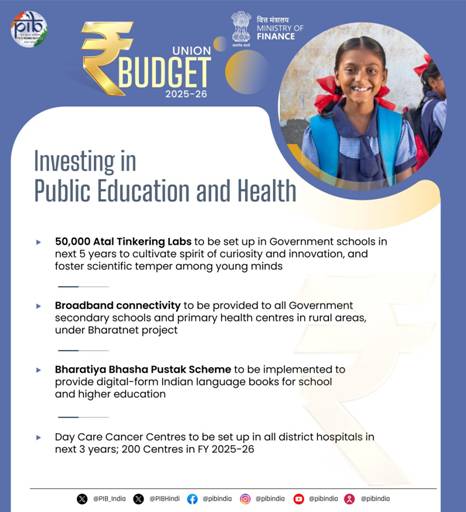Budget 2025-26: Key Measures to Nurture Innovation and Skilling

IN NEWS — Budget 2025-26: Key Measures to Nurture Innovation and Skilling
ANALYSIS
1. Strengthening School-Level Innovation Ecosystem
- The Budget proposes 50,000 new Atal Tinkering Labs (ATLs) in Government schools over the next five years.
- Objective: Cultivate curiosity, innovation, and scientific temper among students.
- Focus: Hands-on learning, STEM exposure, and early-stage R&D mindset.
- Complementary measure: Broadband connectivity to all Government secondary schools and rural primary health centres under BharatNet, enabling digital learning infrastructure.
2. Expansion and Modernisation of Higher Education Infrastructure
- Over the past decade, student strength in IITs has grown from 65,000 to 1.35 lakh.
- Additional infrastructure will be created in the five IITs established after 2014 to accommodate 6,500 additional students.
- Infrastructure expansion is also announced for IIT Patna, especially hostel and allied facilities.
3. Bharatiya Bhasha Pustak Scheme
- The Budget introduces the Bharatiya Bhasha Pustak Scheme, aimed at providing digital-form Indian language books across school and higher education levels.
- Significance:
- Supports National Education Policy objectives on mother-tongue instruction.
- Reduces digital and linguistic barriers in learning.
- Boosts availability of quality academic content in multiple Indian languages.
4. Centres of Excellence for Skilling
- Five National Centres of Excellence for Skilling will be set up with global partnerships.
- Core activities:
- Curriculum design
- Training of trainers
- Skills certification framework
- Periodic assessment reviews
- Target: Equip youth for “Make for India, Make for the World” manufacturing, fostering export-competitive workforce capabilities.
5. Centre of Excellence in Artificial Intelligence (AI) for Education
- A new Centre of Excellence in AI for Education will be created with an outlay of ₹500 crore.
- Purpose:
- Promote AI-driven adaptive learning tools
- Develop India-specific educational AI solutions
- Improve learning outcomes through technology integration
6. Boost to Research, Development & Innovation
- Allocation of ₹20,000 crore for private-sector-driven R&D and innovation.
- Intended to catalyse industry-academia collaborations and accelerate the innovation ecosystem.
- Focus sectors likely include deep tech, manufacturing, frontier science, and industrial R&D.
7. PM Research Fellowship Scheme Enhancement
- Provision of 10,000 fellowships for technological research in IITs and IISc over the next five years.
- Enhanced financial support aimed at retaining top talent in Indian research institutions.
- Aligns with national priorities in building advanced, indigenous research capacities.
NECESSARY STATIC PART (Relevance for UPSC)
- Atal Tinkering Labs: Implemented by Atal Innovation Mission (AIM) under NITI Aayog to encourage innovation and entrepreneurship.
- BharatNet Project: Aims to digitally connect all Gram Panchayats; implemented by Bharat Broadband Network Limited (BBNL).
- National Centres of Excellence for Skilling: Aligned with Skill India Mission and PMKVY frameworks.
- PM Research Fellowship Scheme: Flagship programme to promote doctoral research in premier institutions like IITs and IISc.
- AI Centres of Excellence: Support India’s AI strategy under Digital India and National Education Policy 2020.
Updated – 01 Feb 2025 ; 01:39 PM | PIB | News Source: PIB (https://www.pib.gov.in/PressReleaseIframePage.aspx?PRID=2098380)